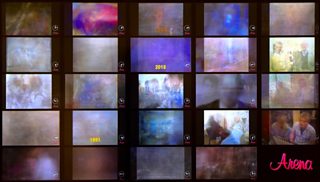Arena: Night and Day - Voice of Time
There’s a horrible moment in one of John Wagner and Carlos Ezquerra’s Strontium Dog strips from the 1970s. Trapped in a fierce gunfight, Johnny Alpha – the Dog of the title – reaches for one of his terrifying sci-fi weapons, a literal “time bomb”. He throws it towards his enemy who is then stuck in a localised time-loop, endlessly repeating the same gesture of violence. As Alpha leaves the scene, he tells his companion that the man will remain in the loop “until he starves to death”. This is the feeling I once had at a twenty-four hour film marathon. It was a weird mix of endurance, machismo and sensory deprivation as the cavalcade of ‘classic’ (i.e. familiar) movies went by. You might think that many things could improve Gary Sherman’s Death Line. Seeing it at three in the morning as it merges hypnagogically into The Flesh and the Fiends is not one of them.
Arena: Night and Day, which had its premiere at the 2015 Cambridge Film Festival, offers an experience very different to this cinematic slow torture. Anthony Wall and editor Emma Matthews have put together a brilliant piece of editing and archival curation. When considering the presentation of Arena in a festival or installation format, the easy thing would have been to wallow in Arena’s formidable cultural pedigree and put together a documentary marathon. Instead, Wall and Matthews took the other, more inventive route and succeeded in constructing a new film out of the highly charged material of the strand. Night and Day is comprised of carefully selected clips that chart the period’s real time passage. Noon to noon we move in synch through the day, The Rolling Stones arrive in Morocco at 12.04pm, George Martin makes his perfect Martini at 1.08pm, Francis Bacon and William Burroughs have tea at 4.27pm …

Arena's technical consultant Andy Armstrong created a screen which plays all 24 hours at the same time. This image was captured by Greg Hinks: each screen is intentionally blurred or in focus to evoke the experience of watching 24 screens at the same time
The result is a long, meditative film that has nothing to do with nostalgia but everything to do with duration. To quote the title of David Thompson’s recent Arena portrait of Nicholas Roeg: “It’s about time”. High time that Arena consolidates its primacy and legacy; time also to realise what, in essence, the series has always been about: contemporary culture. Contemporary is not just a synonym for ‘modern’. It describes the weird experience of sharing the moment with another. Contemporary art brings with it the challenges of this proximity. How do you think through that which we are so close to? How do you analyse or even evaluate that which has no history of opinion behind it? Since 1975, mapping the contemporary landscape has been Arena’s main remit. The house-style developed towards the film essay: contemplative, associative often poetic. Arena: Night and Day offers a stunning development of this approach.
Initially, as someone who raised herself on Arena, the experience of watching the film is that of looking for favourite moments. Soon though, the temporal rhythm makes it clear that this isn’t about a sequence of faces in order of importance, or a tribute reel building to a celebratory crescendo. Rather, the cuts invite you to think about the connection between time and image. The key question becomes "when are we watching?" rather than "what are we watching?". Case in point, at Cambridge the film was streamed into the cinema bar. I walk in shortly before midnight, Bob Marley’s on screen, and everyone’s singing along. Festival microclimates can often be hermetic time zones of their own. All those days in the dark make you squint when you come up for air. Here I very much had the sense that it was midnight and no other time. The film made me think precisely about the moment I was in, not just chronologically but also symbolically. We are experiencing midnight with Marley, joined in the night through the timestamp.
I came out of Arena: Night and Day with renewed faith in diurnal cinema. This was neither Groundhog Day nor a box-set binge. Rather than the bleak terror of the time bomb, Wall and Matthews provide an experience not unlike that described by J.G. Ballard in ‘The Voices of Time’. Twisting, stretching and re-combining the familiar, the film takes us through decades in a day and gets us to think about the ways we choose to time-code the passing of every hour.
Yvonne Salmon is a lecturer at the University of Cambridge. She writes on film, modern and contemporary literature, art, law, and cultural history. She chairs the Cambridge University Counterculture Research Group and directs the Alchemical Landscape Project. www.eviesalmon.com